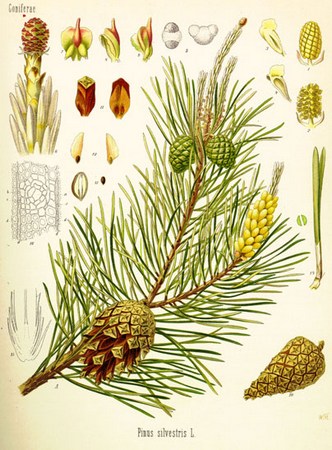Scotch pine – Pinus sylvestris
Coniferous evergreen tree height 40 m, pine family (Pinaceae). Pine is widespread in the forest zone of European Russia and Siberia. For medical purposes harvested pine buds, sap and pine needles.

Scotch pine – Chemical composition
The kidneys contain various pine resin and tannins, essential oil, vitamins, pinicikrin. Pine contains ascorbic acid, tannins and anthocyanin compounds, alkaloida, terpenı - borneol, pinene, limonene and other substances. From pine sap obtained (Turpentine), which is rich in essential oils and terpenoids. By the dry distillation of wood tar get plants. It is composed of resinous substances, oils, phenol, xylene and toluene. In the distillation of resin obtained turpentine pine.
Pine - Pharmacological properties
Herbal medicines from pine buds stimulate secretory activity of mucous membranes of the upper respiratory tract. There was also an expectorant effect of drugs, manifested in the stimulation of ciliary epithelium of the mucous membranes. Besides, extracts of pine buds bactericidal effect on pathogenic microflora of the oral cavity and nasopharynx. Kidneys plants have a weak diuretic and choleretic properties.
The most thoroughly studied pharmacological properties of turpentine refined, or terpintinnogo oil, which has a strong local and general effects on the body of animal. When applied (especially when rubbed) turpentine skin quickly manifested its local irritating effect, is limited to small doses of lesion erythema, and with increasing dose and duration of exposure to these areas of skin appear bubbles, erosion followed by suppuration and necrosis.
Besides, turpentine highly soluble in lipids and penetrates deep into the skin, irritating its receptors and causing reflex changes in the body. Obscherezorbtivnoe action, due to the rapid arrival of turpentine in the blood, manifested symptoms of general central nervous system excitation (increased blood pressure, anxiety, breathlessness). In large doses can cause poisoning turpentine, accompanied by convulsions and death of the animal.
Turpentine and pine derived from less toxic products - turpentine and Terpin hydrate - excreted through the kidneys, while providing some antiseptic effect on the urinary system. Antiseptic is also reflected in the allocation of terpene products through the mucous membranes of the respiratory system. Besides, Terpin hydrate markedly increases the secretion of the bronchi, It liquefies mucus and promotes a more rapid evacuation of the airway.
Scotch pine – Use in medicine
The infusion and decoction of pine buds thanks to anti-inflammatory and antiseptic properties, and the ability of phlegm and accelerate the evacuation of its use in diseases of the upper respiratory tract. Usually pine buds prescribed in combination with other medicinal plants in the form of fees and teas, as well as mixtures inhalable. So, eg, pine buds included in the number of infants fees.
If earlier turpentine often used as a means of distracting external respiratory diseases, at the present time due to the introduction into medical practice more efficient means it is rarely used.
Very popular Terpin hydrate, which is obtained from pinene turpentine fraction. This drug is used as an expectorant, contributes to liquefaction of sputum, its more rapid release. Terpine administered in combination with other expectorant in chronic bronchitis, bronchopneumonia and other inflammatory diseases of the respiratory system.
The needles of pine is a valuable vitamin preparation. It is used for infusions and concentrates for the prevention and treatment of hypo- C and beriberi. Besides, pine needle enters the antiasthmatic medicine, used in bronchial asthma.
Pine tar is applied topically as an ointment for skin diseases (psoriasis, eczema and others.), He is a member of various ointments, widely used in medicine (eg, in the ointment Vishnevsky).
Scotch pine – Formulations, Dosing and Administration
Oil of turpentine refined, turpentine refined. Apply for rubbing into the skin in a mixture of petroleum jelly (1:2) sciatica, ljumʙoişialgii, neuralgia, miozitax, rheumatism.
Liniment turpentine complex used for rubbing the joints in arthritis and other inflammatory conditions.
Terpingidrat is used as an expectorant for bronchitis, adults 0.25-0.3 g, children 0,025-0,25 g 2-3 times a day.
Pinaʙin – 50 % solution of heavy fraction oils (from the needles of pine or spruce) in the peach butter. It has antispasmodic effect on the muscles of the urinary tract, bacteriostatic effect. Apply with urolithiasis inward 5 drops on sugar 3 times a day for 15-20 minutes before eating. The course of treatment 4-5 weeks. In renal colic once used to 20 drops on sugar.
Side effect: large doses can cause irritation of the mucous membrane of the stomach and intestines, hypotension and general depression. Contraindicated in nephritis and nephrosis.
A decoction of pine buds: 10 g (1 tablespoon) raw material is placed in an enamel bowl, Pour 200 ml (1 glass) hot boiled water, capped and heated in a boiling water bath 30 m, cooled at room temperature 10 m, filter, the remaining raw materials squeeze. The volume of the resulting broth bring boiled water to 200 ml. The prepared broth is stored in a cool place no more 2 d.
Take 1 / 2-1 / 3 cup 2-3 times daily after meals as an expectorant and disinfectant.
The raw material stored in a dry, cool place.
